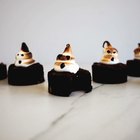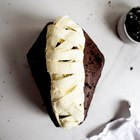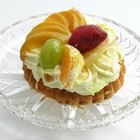shironosov/iStock/GettyImages
The simplest forms of cake icing consist mainly of powdered sugar and butter, beaten together until smooth with a bit of vanilla and milk. This type makes a perfectly serviceable icing, but it's relatively heavy and has a tendency to tear the lightest and most delicate of cakes or to compress them with its weight. Professional bakers use a very light whipped icing called Italian buttercream for airy cakes. It's as light and delicate as the cakes themselves, but it retains a rich, buttery flavor.
Frothing at the Mouth
The basic ingredient in light, whipped icing is egg whites. When whipped to a fine, frothy meringue, they incorporate enough air to be almost weightless. Vintage cookbooks frequently feature an old-fashioned icing based on meringue called boiled icing or seven-minute icing. The baker brings a mixture of sugar and water to a boil, simmering it until it reaches a temperature of 240 degrees Fahrenheit. The sugar syrup must be whipped into the meringue in a thin stream, which gently cooks the egg whites and both sweetens and stabilizes the meringue. This makes an icing that's fat-free, brilliantly white and very fluffy.
Italian Meringue
Boiled icing is a good cake topping in its own right, but it's limited. It's very sweet, almost marshmallow-like, and its flavor is correspondingly one-dimensional. Professional bakers call it Italian meringue, and they use it to decorate desserts such as Baked Alaska. Because it's already cooked, it can be placed on the most delicate desserts and served immediately with no additional heating. At most, it requires rapid browning with a torch just to make it look prettier. However, it lacks richness and buttery flavor, so to use as an icing, bakeries take this basic recipe a step further.
Making Italian Buttercream
To convert the meringue or boiled icing into a true buttercream icing, leave it in the mixing bowl. Once it's cooled to room temperature, start whisking in small quantities of softened butter. As each addition is incorporated, add more until the entire amount of butter is used up. The meringue will deflate slightly as you add the butter, an inevitable result of mixing fat with meringue, but it retains enough air to make an exceptionally light icing with the richness and flavor of butter. Because it's based on an Italian meringue, professional bakers call it Italian buttercream.
Using Your Buttercream
Italian buttercream is the lightest and fluffiest of bakery icings, and it's usually used on the lightest of cakes. It's a perfect complement to angel food cake, for example, or the lightest and fluffiest of sponge cakes. You can smooth it to a perfectly even finish with your spatula, and it holds its shape well enough to be piped into rosettes and shell borders. For a homier and less-polished appearance, apply the Italian meringue in generous dollops with the tip of your spatula. Give the spatula a twist each time, so the icing makes soft swoops and peaks all over the cake.
Related Articles

The Difference Between Whipped Icing & ...

Do You Need to Refrigerate Whipped ...

Can You Use Heavy Cream When Making ...

How to Add Meringue Powder to ...

How to Make Frosting Hard for a Cake

Softened vs. Melted Butter When Baking

How to Make Brownies With Little Ghosts ...

Can You Color Boiled Icing?

Can Softened Frosting Harden Over a ...

How to Use Gelatin to Thicken Frosting
What Frosting Goes Well With Angel Food ...

How to Decorate Cake Using Heavy ...

How to Make a Mummy on a Coffin Cake

How to Fix Grainy Whipped Ganache
Best Homemade Cream Cheese Frosting

How to Melt Marshmallows for Icing

How to Make Almond Buttercream Frosting
Easy White Cake Recipe

How to Keep Your Buttercream Icing With ...

What Can You Use Instead of Powered ...
References
- The Professional Pastry Chef; Bo Friberg
- The American Woman's Cookbook, Wartime Victory Edition; Ruth Berolzheimer (Ed.)
Writer Bio
Fred Decker is a trained chef and prolific freelance writer. In previous careers, he sold insurance and mutual funds, and was a longtime retailer. He was educated at Memorial University of Newfoundland and the Northern Alberta Institute of Technology. His articles have appeared on numerous home and garden sites including GoneOutdoors, TheNest and eHow.